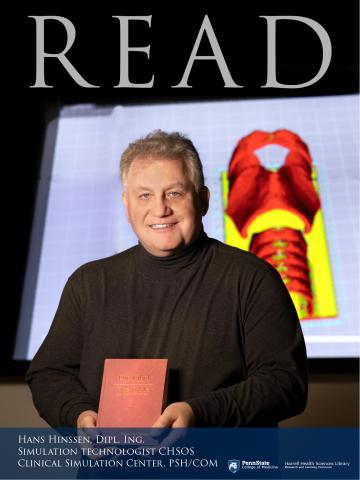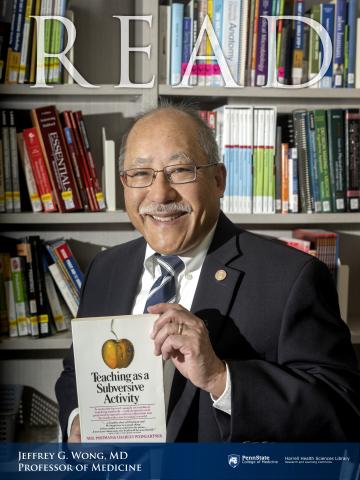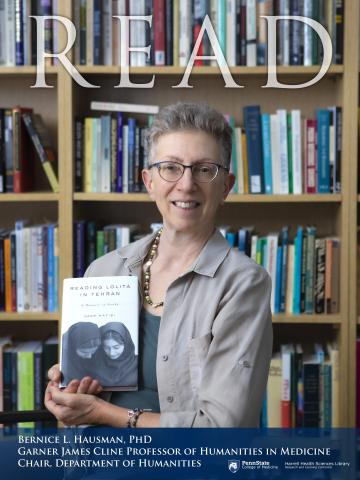You are here
Harrell READers
“Harrell READers” celebrates the relationships between the library and the faculty, staff, and students of the Penn State College of Medicine and Penn State Milton S. Hershey Medical Center community. Library partners and supporters are asked to share their top book pick in the quarterly library newsletter (@Harrell.lib) and are featured on a READ poster in the library for one year.
Use the Harrell READers Nomination form to submit a nomination for this year's award cycle. Questions about the program may be directed to Marie Castaneda.
Jen McCormick , PhD, MPP
Associate Professor, Department
of Humanities; Faculty, Biomedical Sciences Program; Lead, CTSI Research Ethics Core
Where the Crawdads Sing -- Delia Owens, 2018
I chose Where the Crawdads Sing by Delia Owens as my book because of the wonderous detail of the world of the marshlands of North Carolina that is provided. As a biologist, this detail is very appealing to me and my awe of the natural world.
Read the complete messageI chose Where the Crawdads Sing by Delia Owens as my book because of the wonderous detail of the world of the marshlands of North Carolina that is provided. As a biologist, this detail is very appealing to me and my awe of the natural world. Where the Crawdads Sing is one of my favorite stories because of the descriptive narrative and because of the mystery that is embedded within the story (I love the mystery genre).
Where the Crawdads Sing is about an abandoned girl named Kya maturing into an adolescent and young woman. The story starts with Kya living with various family members – who slowly over time leave the shack in the marsh in which they all live. For some time Kya and her father, Pa, manage together, with Kya learning to prepare food and fish and learning the ways of the marsh. Eventually Pa leaves and Kya is left to fend for herself. Surprisingly, Kya is able to manage, and her resourcefulness is part of what makes the story. Another part of the story is the discoveries of the natural world of the marsh that Kya makes and of her collection of plants, feathers, and other artifacts of the marsh in which she inhabits.
Kya meets Tate Walker, a friend of one of her brothers, during one of her exploration trips in the fishing boat. Kya and Tate develop a friendship that eventually leads to something more. Tate teaches Kya to read and brings her biology and other textbooks that Kya uses to teach herself. When Tate leaves for college and fails to return to visit her, Kya is crushed. She ends up turning to another young man for friendship, Chase Andrews. Chase ends up taking advantage of Kya sexually, while at the same time seeing other women. Eventually the story leads to Chase’s murder and the mystery around this.
Overall, I found Where the Crawdads Sing a wonderful story that kept me wanting to turn the page. I have read the book several times, and each time I find I enjoy it more. To date this, this is Delia Owens’ only work of fiction, and based on my enjoyment of Where the Crawdads Sing, I do hope she ventures further into the world of fiction.
Hans Hinssen , Dipl. Ing
Simulation Technologist CHSOS
Clinical Simulation Center, PSH/COM
Owning or reading the books of the bible is and has been illegal in many countries. Up to the early sixties it was still that way in Belgium, about one hour from where I grew up. This is why I cherish religious freedom in this country.
Read the complete messageOwning or reading the books of the bible is and has been illegal in many countries. Up to the early sixties it was still that way in Belgium, about one hour from where I grew up. This is why I cherish religious freedom in this country. Personal thoughts ought to remain free and without sanction.
Why this book greatly affected my personal life and career? In 2002, after a successful initial job interview in Harrisburg to work as a clinical CRM specialist, I returned from my second internal job interview and visit in the US without an answer. Days before Christmas I called and got a no. My shipping container was already half packed. I wondered and asked God many times for a sign, whether it is still the right move to cross the Atlantic, to leave Germany and a good pay behind.
Early the next morning, still seriously thinking about my decision, I prepared my first cup of coffee and then moved my inspirational flip calendar to the next day: This time it was not an idiom or wise saying, instead it was a verse from scripture where God commands Moses to cross the great waters and not to worry about what he would meet on the other side. Like a sign, it was addressing exactly my heartfelt question and situation. Going forward, throughout the years, my God has always provided through people and employers.
For me, the book is about the love of a father, the faith and obedience of the heart of a child, and the blessings for living according to his guidance. And it is about the initiative of the father to restore relationships when they are broken. And especially the sacrifice that opens the door to restoration. Faith requires being alert and having all the little grey cells activated. Life always has a spiritual and a physical aspect. Reading scripture in various and the original language, and with cultural background information in mind, unlocks meaning.
These principles can be applied to immersing yourself into any new professional specialty: it is defined by a new language, a new terminology, new definitions every time. And it requires a structural approach in order to connect the dots. Even 3D printing can and was such a new realm to me in 2015 when I started using it. And the Harrell Health Science Library has been an extremely valuable partner in this endeavor to design, modify and produce new task trainers for use in clinical simulation. I highly appreciate the talented staff who were and are assisting me in impactful ways to provide better ways of training for the world of medical professionals. Thank you!
Jeffrey G. Wong , MD
Professor of Medicine
Teaching as a Subversive Activity
by Neil Postman and Charles Weingartner, 1969
This book, “Teaching as a Subversive Activity,” was an important reference for me as I sought to learn more about teaching and achieving success for our learners.
Read the complete messageI was recruited to the Penn State College of Medicine’s University Park Regional Campus in 2015 to help construct and create a novel approach for teaching medical students in the State College community away from the Academic Medical Center at Hershey. After a considerable amount of planning and study by the educational leaders of the College, an inquiry-based approach was decided upon.
This book, “Teaching as a Subversive Activity,” was an important reference for me as I sought to learn more about teaching and achieving success for our learners. The book lays out in fundamental terms how an inquiry-based approach to education might be constructed. It was extremely controversial when it was first published in 1969, and it remains just as controversial now in 2023 if current reviews and comments posted on the Internet are to be believed.
The thesis of this book, directly from the introduction, is, “that change --- constant, accelerating, ubiquitous --- is the most striking characteristic of the world we live in and that our educational system has not yet recognized this fact.” Much of traditional education, the authors contend, is focused on the business of transferring information – facts, concepts, truths --- to the learners. Learners are correspondingly rewarded by how well they can successfully repeat back to the teachers that which they were told. Traditional learning for the student, then, is an exercise of striving to become as knowledgeable as their teachers.
But this recitative prowess that tends to define success in medical school is vastly different from the deductive reasoning that is required for success in graduate medical education (internship/ residency) and for physicians who are striving to keep current while in practice (when there is no teacher around to pass judgment). Inquiry-based approaches help the learners acquire the “question-asking” and “information-seeking” skills necessary for solving future problems and thus allow them to adapt to the ever-changing needs of their patients and the always evolving science of medical knowledge.
It is gratifying to be involved with such a cutting-edge and forward-thinking method for training medical students at the Penn State College of Medicine.
Bernice L. Hausman , PhD
Garner James Cline Professor of Humanities In Medicine
Chair, Department of Humanities
Reading Lolita in Tehran: A Memoir in Books
by Azar Nafisi, 2003
Reading Lolita in Tehran is a testimony to the power of books to understand, amplify, and shape real life.
Read the complete messageI was the kid with the flashlight under the covers at night. Now, I am the adult with books in every room of her house.
When I was in college, the library was a place where physical objects to read (books, microfiche, scholarly journals, newspapers) were located and where one could study (preferably in the stacks, where the books were). While libraries still have study tables, often they are no longer repositories for books and other physical artifacts—much of the print collection is stored elsewhere, journals are online rather than in print, and what was once saved as microfiche is now born digital. Instead, libraries provide access to computers, opportunities to borrow or rent gadgets, and places to congregate or hold events. For those of us with strong memories of time spent in libraries surrounded by things to read, these developments are disorienting.
Reading Lolita in Tehran is a testimony to the power of books to understand, amplify, and shape real life. Azar Nafisi returned to Iran in 1979, as a 30-year-old with a PhD in literature and a desire to play a part in the transformation of her native country, a transformation that early on takes a different route than the one she fought for. The book chronicles her experiences teaching at the University of Tehran and two other universities, her struggles with the Islamist regime and its repression of women and political dissidents, the formation of her private literature class for female students, and her decision to leave Iran for the United States after 18 years in the country. Throughout, iconic literary texts—Lolita and Invitation to a Beheading, by Vladimir Nabokov; The Great Gatsby, by F. Scott Fitzgerald; Washington Square and Daisy Miller, by Henry James; and Pride and Prejudice, by Jane Austen—serve as interpretive guides for what is happening in her life.
During her tenure at the University of Tehran, from which she was fired for refusing to wear a veil, her students put Gatsby (the book) on trial. Nafisi herself represented the book as defendant. Asked by the defense attorney whether her aim (as the book) was “not a defense of the wealthy classes?” she answers: “Imagination in [all] these works is equated with empathy; we can’t experience all that others have gone through, but we can understand even the most monstrous individuals in works of fiction” (132). Reading Lolita in Tehran challenges us to remember the power of books to give us access to a world larger than the one we typically inhabit and to extend moments of grace to all those we encounter in their pages. It also reminds us that books come to inhabit us and our ways of being in the world.
Nabokov’s Lolita, incongruously, is the emblem for all that was happening—and continues to happen—to those oppressed: “it went against the grain of totalitarian perspectives” (35) because it shows us a character who attempts to annihilate the personhood of the person he purports to love. Later in the book, after she has been fired from her teaching position, forced to wear a veil, and forbidden to touch men or shout in public, Nafisi writes, “I felt light and fictional, as if I were walking on air, as if I had been written into being and then erased in one quick swipe” (167). Her book reminds us that fictionality is both real and ephemeral, grounding us in our lives and providing escape routes when necessary.



